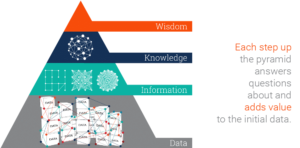
Most survey programs provide information: “Our Net Promoter Score (NPS) is 25, up from 22, compared to our competitive benchmark of 30.” While those figures might be interesting, they don’t provide the context that is essential for prompting action.
As Heart of the Customer has been conducting interviews with CX pros (more than 70 so far this year!), we’ve found some common themes – notably that most programs use NPS as their measurement, and most don’t provide much context for those scores.
This brings back memories of my graduate school class on knowledge management, and an illustration of the difference between data, information, knowledge, and wisdom. 
The survey communication mentioned above qualifies as information. It provides the “who” and “what”…but not the critical “why” or “how” that drives business outcomes. In the situation above, we know that we’ve seen a small improvement, but not whether it’s meaningful or why it happened. And we know we’re below the competition, but not what we need to do to close the gap.
This is a missed opportunity.
Many programs are stuck at merely providing information, but some of our clients take it to the next level. Last week, I hosted a Minneapolis CXPA event that because of the coronavirus was forced to move online. Fortunately, this allowed me to feature Jen Zamora of Dow (based in Michigan) and Roxie Strohmenger of Ultimate Software (in Florida) – two CX leaders who have each built amazing, impactful CX programs in just over two years.
Their stories aren’t mine to tell – although I hope to get them to present on future webinars, and Jen is telling her story on LinkedIn. But both spoke about how they built their programs by providing not just information, but knowledge and wisdom as well. (Okay, they didn’t use the word “wisdom,” but that’s the outcome, and I think everyone who attended would agree with that!)
So now let’s revisit that survey data example above. Imagine if instead of just rattling off scores, you told your business:
“Our NPS moved from 22 to 25. While we’re still below the industry benchmark of 30, we are improving. The gains primarily came from customers experiencing our new account management model. However, these gains were offset by drops from customers using product XZY, who suffered from service issues.
“Promoters had an average quarterly margin of $1,258, compared to passives at $987, and detractors at $693. The top cause of low scores is outstanding issues: customers with trouble tickets open over one week in the last quarter were 70% more likely to be detractors.”
Quite a difference, isn’t it? Adding compelling context to your scores in terms that are meaningful to the business is clearly a game-changer. To attain this capability, bring in business information from your siloed systems.
Here are five steps you can take to move from providing information to delivering wisdom, and in turn, driving impact.
Another benefit of integrating that siloed data and tying it to specific outcomes is that you can then use tools such as the Qualtrics Predict iQ platform to identify at-risk customers with churn prediction data and act preemptively to reduce attrition rates. Based on the prediction, you can program targeted interventions to, for example, trigger an email or a Salesforce update. Tools like this also help you tie initiatives directly to impact.
One indirect benefit of the coronavirus pandemic is that it’s pushing CX programs to focus more on ROI. (And it allowed Jen and Roxie to “attend” our CXPA event.) By linking your work to what the business is focused on, you can ensure your program creates lasting impact.
Are you adding wisdom and context to your survey scores? Tell us how!

